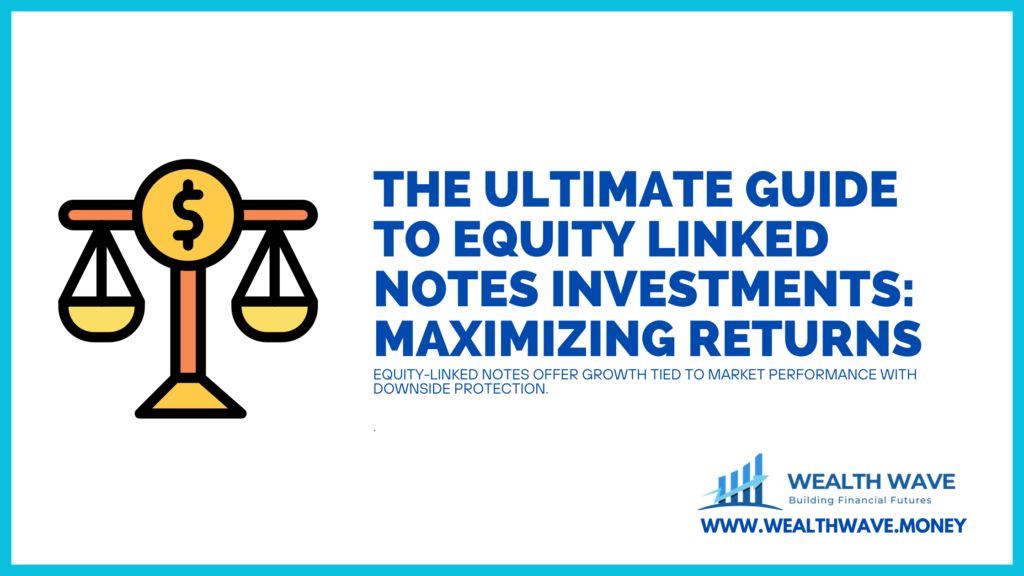
Navigating the investment landscape can sometimes feel like trying to find a needle in a haystack. With an array of options at our fingertips, pinning down what aligns with our goals can be downright daunting.
Believe me, we’ve sifted through piles of fixed income investments, bonds, and structured products in search of something that packs a bit more punch than your average return. Our quest eventually led us to Equity Linked Notes Investments (ELNs), a fascinating hybrid that marries the steadiness of fixed income with the potential for juicier returns tied to equity performance.
Our deep dive into ELNs revealed that they’re far from just another item on the debt instrument menu; they’re a sophisticatedly crafted structured product aiming to sprinkle some variety into our portfolios.
Anchored in equity derivatives, with the allure of added gains tethered to market movements or specific stocks, ELNs sparkle as an enticing option for those looking to zest up their investment ensemble.
This article walks you through The Ultimate Guide to Equity Linked Notes Investments—their perks, pitfalls, and mechanics—to help you decide if they mesh well with your investing philosophy. Shall we embark on this journey together?
Key Takeaways
• Equity-Linked Notes (ELNs) combine the safety of bonds with chances to earn more when stocks do well. They let investors make money from stocks while still offering some protection.
• While ELNs can protect your initial investment and offer ways to earn more, they also come with risks like market changes and complexity. It’s important to know these before you invest.
• ELNs need a good understanding of how stock markets work since their performance affects your returns. If you’re thinking about investing in ELNs, talking to a financial advisor can help make sure it fits your goals.
• Investing in ELNs is best for those who believe the stock market will go up because their potential profit is tied to how well the equity or stock index does.
• Before putting your money into ELN, make sure you understand all the details like how much extra money you could make based on stock performances, any guarantees on getting back your main investment, and other terms that could affect what you earn or lose.
Understanding Equity Linked Notes Investments (ELNs)

Equity-Linked Notes (ELNs) are investment products with unique features that combine the characteristics of bonds and equities, providing investors with a customizable risk-return profile.
They offer potential for higher returns while also providing some downside protection.
Definition of ELNs
An Equity-Linked Note (ELN) is an investment product that combines a fixed income investment with the potential for additional returns linked to the performance of equities. These structured products, typically issued by financial institutions like investment banks or subsidiaries of commercial banks, merge the security of bonds with the excitement of equity markets.
They offer investors a base payout from the bond component and extra earnings depending on how well certain stocks or indices perform.
As debt instruments, ELNs are akin to bonds but with a twist: their payouts are connected to underlying equity entities such as indexes or individual stocks. This unique setup allows them to serve both as sources for income generation and tools for potentially higher returns based on stock market movements.
ELNs target retail investors who seek diversification in their portfolios along with the chance for enhanced returns beyond what traditional fixed-income securities provide. Despite their attractive features, these products come with significant risks and complexities, emphasizing the importance for investors to fully understand ELNs before adding them to their portfolios.
Features of ELNs
Moving from the definition of ELNs to their features, it’s crucial to note that these structured products are designed for income generation and to offer additional returns based on equity performance.
They typically derive their payouts from an underlying equity index or individual stock. Moreover, ELNs are usually issued by financial institutions such as investment banks or commercial bank subsidiaries, making them accessible in the derivatives market.
These instruments provide potential for added returns beyond the fixed income component and can aid in diversifying an investor’s portfolio.
ELNs serve as suitable tools for income generation and should be reviewed meticulously before investing, all while considering consulting a financial advisor regarding one’s specific situation.
How ELNs Work
ELNs are debt instruments, typically bonds, that offer investors the potential for enhanced returns based on the performance of underlying equities. When investing in ELNs, it’s essential to remember that these financial instruments are linked to an underlying equity index or individual stock.
This means their payouts are contingent upon the performance of these equities. Callable securities and credit default swaps may be utilized in ELN structures by financial institutions like investment banks or commercial bank subsidiaries.
Investors should note that ELNs can provide additional returns beyond fixed income components and are often used for income generation with added equity-based returns. It is advisable for investors to understand the risks and features associated with ELNs before delving into this type of investment.
Advantages and Disadvantages of ELNs

ELNs offer potential benefits like principal-guaranteed notes and leverage, but they also present risks such as the potential for loss and complexity.
Principal-Guaranteed Notes
Principal-guaranteed notes are a type of Equity-Linked Notes (ELNs) that offer investors the security of having their initial investment amount protected. These notes provide a guarantee from the issuer to return at least the original investment value, regardless of the performance of the underlying equities.
They are often marketed as a low-risk option due to this principal protection feature. However, it’s important to note that while these notes protect against loss of principal, they may not shield against other risks associated with ELNs such as opportunity costs and limited potential for higher returns.
Principal-guaranteed notes underpin a sense of security for investors by safeguarding their initial investment amount from market fluctuations. They serve as an entry point into structured products for risk-averse individuals who seek downside protection along with potential equity-linked returns.
These notes can be issued by financial institutions like commercial bank subsidiaries or investment banks and tend to attract conservative investors looking for combined fixed income and equity exposure without risking their capital.
Leverage
ELNs often involve exposure to equity market movements through the use of leverage. Leverage amplifies potential returns by using borrowed funds to increase the size of investments in equities.
This can magnify gains, but also heightens the risk of larger losses if the underlying assets perform poorly. It’s crucial for investors to understand that while leverage can enhance profits, it significantly increases the level of risk associated with ELNs.
Careful consideration and evaluation are necessary when leveraging investments through ELNs to align with individual risk tolerance and investment goals.
Incorporate pertinent statistics into educational content –
An example would be: “Leverage allows an investor in an ELN linked to a stock index, say S&P 500, to gain exposure worth $200,000 while investing only $100,000.
Participation Rates
Participation rates determine how much an investor will benefit from the performance of the underlying equities. They are typically expressed as a percentage and can vary based on market conditions and the terms of the specific ELN.
Higher participation rates mean that investors can capture a larger portion of the gains in the underlying equities, potentially leading to higher returns. However, it’s crucial to note that these rates may also cap the maximum return an investor can earn, so understanding and evaluating participation rates is essential for potential ELN investors.
Investors should examine participation rates carefully when considering ELNs as they directly impact potential returns from the investment. It’s advisable to comprehend how these rates function within each specific ELN product before making any investment decisions.
Risks of ELNs
ELNs carry potential for loss due to market fluctuations and the complexities of their terms and conditions. To understand more, continue reading our blog.
Potential for Loss
Investing in Equity-Linked Notes (ELNs) carries inherent risks, and investors should be aware of the potential for loss. Market fluctuations can impact ELNs, leading to a decrease in the value of the investment.
It’s essential to note that these instruments do not guarantee returns and are subject to market volatility, which can result in financial losses. Therefore, individuals considering ELNs as part of their investment strategy should carefully evaluate their risk tolerance and thoroughly understand the complexities involved.
The high level of complexity associated with ELNs necessitates a cautious approach due to potential downsides such as market downturns impacting returns from equity-linked investments.
Consequently, thorough consideration is crucial before venturing into this realm, bearing in mind that it might not suit all investor profiles due to the associated risks.
Complexity
ELNs entail a considerable level of complexity due to their structured nature. They are designed to offer investors the potential for enhanced returns while protecting their principal investment; this, however, requires a deep understanding of financial markets and instruments.
The complexities stem from the fact that ELNs are linked to the performance of an underlying equity index or individual stock, requiring investors to have a grasp on market movements and trends in order to make informed decisions.
Additionally, as they are typically issued by financial institutions like investment banks or commercial bank subsidiaries, navigating through the terms and conditions demands meticulous attention.
The ever-changing landscape of financial products further underpins the need for tailored knowledge towards ELNs. With factors such as leverage and participation rates influencing returns, it is essential for investors not only to comprehend these variables but also acknowledge that any potential loss is inherent in this investment product.
The complexities involved necessitate an investor’s ability to weigh up both risks and rewards meticulously before embarking on an investment journey with ELNs.
Benefits of ELNs

Higher Potential Returns
Equity-Linked Notes (ELNs) offer the potential for enhanced returns in an investment portfolio. They combine a fixed income investment with additional returns tied to the performance of equities, potentially leading to higher potential returns than traditional fixed income instruments.
ELNs are designed to enhance income generation by offering additional returns based on the performance of underlying equities, making them an attractive option for investors seeking more than just steady income from their investments.
Investors need to recognize that while ELNs present the opportunity for higher potential returns, they also carry significant risks. Therefore, it is advisable to meticulously understand both the benefits and risks associated with ELNs before embarking on investing in them.
Diversification
Diversification is important for managing risk in investments. With Equity-Linked Notes (ELNs), it provides an opportunity to spread the investment across different asset classes, reducing overall portfolio risk.
ELNs offer exposure to equities while also having a fixed income component, which can help balance the overall risk and return profile of an investment portfolio. By including ELNs alongside other traditional investments like stocks and bonds, investors can potentially achieve better diversification and improve their overall portfolio’s risk-adjusted returns.
Moreover, because ELNs are linked to the performance of an underlying equity index or individual stock, they can add another layer of diversification within a portfolio. Therefore, by tapping into the potential benefits offered by ELNs, investors may effectively enhance their portfolios’ diversification and potentially enjoy more stable returns irrespective of market conditions.
How to Invest in ELNs

To invest in ELNs, consult a financial advisor for guidance and consider it only if you have a bullish outlook. For more insights, read the full blog.
Suitable for Investors With a Bullish Outlook
Investing in Equity-Linked Notes (ELNs) is suitable for investors with a bullish outlook. ELNs offer the potential for higher returns tied to the performance of equities, making them attractive for those optimistic about the market.
Additionally, these notes can provide an opportunity for income generation and enhanced returns based on the performance of underlying equities. However, it’s important to note that ELNs carry significant risks and are not appropriate for risk-averse investors or those who do not comprehend the product fully.
Therefore, understanding both the potential benefits and risks of ELNs is crucial before considering them as part of an investment strategy.
Furthermore, consulting a financial advisor can help investors tailor their portfolios towards achieving diversification while also unlocking potential returns associated with ELNs.
It’s essential to carefully assess one’s risk tolerance and thoroughly understand how these instruments work before incorporating them into an investment plan.
Consider Consulting a Financial Advisor
Considering the complexities and potential risks associated with Equity-Linked Notes (ELNs), it is advisable to consult a financial advisor before investing. A financial advisor can provide tailored guidance based on individual risk tolerance, investment objectives, and understanding of ELNs’ features and terms.
By seeking advice from a financial professional, investors can make well-informed decisions aligned with their financial goals while navigating the complexities of these instruments.
Understanding the ever-evolving realm of investments like ELNs requires meticulous assessment, where a financial advisor’s firsthand experience can unlock the secrets behind these products.
Engaging with an expert not only underpins prudent decision-making but also ensures that investors are equipped to dive into this bespoke investment opportunity with confidence in their strategy.
Understand the Terms and Conditions
Before investing in Equity-Linked Notes (ELNs), it is crucial to carefully understand the terms and conditions. ELNs are debt instruments linked to the performance of an underlying equity index or individual stock, usually issued by financial institutions such as investment banks or commercial bank subsidiaries.
It’s essential for investors to comprehend that ELNs carry significant risks and are not suitable for risk-averse individuals or those who do not fully grasp the product. Additionally, prospective investors need to thoroughly examine key terms like coupon rates, principal protection features, participation rates, and potential repayment structures before considering ELN investments.
Understanding these terms and conditions will enable investors to make informed decisions about whether ELNs align with their investment goals and risk tolerance levels. Taking into account these facets ensures that investors engage in well-informed investment practices without unforeseen complexities.
Conclusion
In conclusion, Equity-Linked Notes (ELNs) fuse fixed income investments with equity-linked returns. Understanding ELNs’ features and workings is crucial for potential investors. ELNs offer the allure of higher returns but come with significant risks.
When considering an investment in ELNs, consulting a financial advisor is advisable. The potential for diversification and enhanced portfolio returns makes them appealing to certain investors
FAQs
Q1. What are Equity Linked Notes Investments?
Ans. Equity Linked Notes Investments involve buying notes linked to assets like convertible bonds, hedge funds or asset-backed securities from a subsidiary.
Q2. Can you explain the role of convertible bonds in Equity Linked Notes Investments?
Ans. Convertible bonds play a part in Equity Linked Notes Investments as they can be converted into a predetermined amount of the company's equity at certain times during its life, usually at the discretion of the bondholder.
Q3. Are Principal-protected notes involved in this type of investment?
Ans. Yes, principal-protected notes are often used in Equity Linked Note investments because they aim to protect your original investment while offering potential returns based on market performance.
Q4. How do hedge funds relate to these investments?
Ans. Hedge funds can also be tied with equity-linked note investments as underlying assets providing higher return potentials but also come with increased risk levels.




